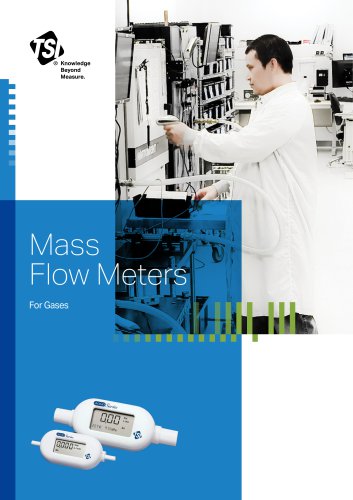 Website:
TSI
Website:
TSI
Group: TSI
Catalog excerpts

MAKING ACCURATE MASS DISTRIBUTION MEASUREMENTS WITH TSI’S MODEL 140 REAL-TIME QCM-MOUDI™ IMPACTOR: BEST PRACTICES APPLICATION NOTE QCM-MOUDI-001 (A4) What Does the Real-Time QCM-MOUDI™ Impactor Offer? The Model 140 Quartz Crystal Microbalance (QCM) MOUDI™ Impactor is a unique instrument that allows users to perform real-time, size-segregated, mass concentration measurements for solid particles smaller than 2.5 µm. Mass measurements are made using a first-principles technique (i.e., Quartz Crystal Microbalance), which means that no assumptions are needed regarding optical properties, density, or shape factor of the collected particles. This first-principles technique means that calibration of the QCM crystals is not r
Open the catalog to page 1
As with any research-grade instrument, care must be taken to ensure that the QCM-MOUDI™ impactor has the conditions it needs to fulfill its ability for providing highly accurate, real-time mass concentration data. This “Best Practices” document describes how to determine what accessories you may need, what settings you should use, and what maintenance schedule you should follow to ensure that you are gathering the most accurate data. What Accessories do I Need? Since the applications for QCM-MOUDI™ impactor vary widely, the list of required accessories can vary significantly too. To...
Open the catalog to page 2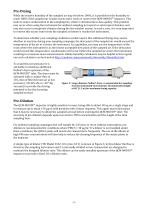
Pre-Drying While the relative humidity of the sampled air may be below 100%, it is possible for the humidity to reach 100% if the sampled air is quite warm and it cools en route to the QCM-MOUDI™ impactor. This leads to water condensation in the sampling line, which is detrimental to data quality. This problem may occur when using the instrument for ambient sampling in tropical or sub-tropical climates, and may also occur in temperate climates during the hot weather season. In such a case, it is very important to remove this excess water from the sampled air before it reaches the...
Open the catalog to page 3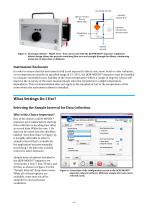
Incoming aerosol Capillary volume flow Bypass volume flow to HEPA filter Regulating valve Capillary volume flow measurement Diluted aerosol Figure 3: The bypass diluter - Model 3332 - that can be used with the QCM-MOUDI™ impactor. (right) the diluter design allows the particle-containing flow to travel straight through the diluter, minimizing losses due to impaction or diffusion. Instrument Enclosure In order to ensure that the instrument itself is not exposed to direct rain, snow, wind or solar radiation, or to temperatures outside its specified range of 15–30 °C, the QCM-MOUDI™ impactor...
Open the catalog to page 4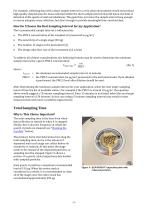
For example, collecting data with a short sample interval in a very clean environment would not produce high-quality data because the mass collected within the short sample interval may fall below the limit of detection of the quartz crystal microbalances. The goal, then, is to have the sample interval long enough to ensure adequate mass collection, but short enough to provide meaningful time-resolved data. How Do I Choose the Best Sampling Interval for my Application? The recommended sample interval is influenced by: The PM2.5 concentration of the sampled air (measured in µg/m3) The...
Open the catalog to page 5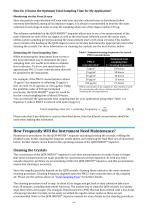
How Do I Choose the Optimum Total Sampling Time for My Application? Monitoring via the Front Screen Since the particle concentration will vary with time, and the collected mass is distributed (often unevenly distributed) among all six impactor stages, it is always recommended to monitor the mass collected at each stage in order to stop the sampling when one of the stages reaches 150 g. The software embedded on the QCM-MOUDI™ impactor allows you to see a live measurement of the mass collected on each of the six stages, as well as the total mass collected across the entire stack, within a...
Open the catalog to page 6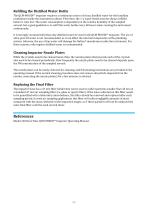
Refilling the Distilled Water Bottle The QCM-MOUDI™ impactor requires a continuous source of clean, distilled water for the humidity conditioner inside the instrument cabinet. Therefore, the 1-L water bottle must be always refilled before it runs low. The water consumption is dependent on the relative humidity of the sampled aerosol, but a good guideline is to refill the water bottle every 48 hours when running the instrument continuously. It is strongly recommended that only distilled water be used in the QCM-MOUDI™ impactor. The use of ultra-pure DI water is not recommended, as it can...
Open the catalog to page 7
TSI and TSI logo are registered trademarks of TSI Incorporated. QCM-MOUDI is a trademark of TSI Incorporated. Nafion is a registered trademark of E. I. Du Pont de Nemours and Company Corporation. TSI Incorporated – Visit our website www.tsi.com for more information. USA UK France Germany
Open the catalog to page 8All TSI catalogs and technical brochures
-
BIOTRAK®
2 Pages
-
Pharma-Life Science brochure
3 Pages
-
Particle Instruments Catalog US
44 Pages
-
SidePak AM520
92 Pages
-
TSI PARTICICLE TECHNOLOGY
44 Pages
-
Flexible lab control options
2 Pages
Archived catalogs
-
Mass Flow Meters for Gases
4 Pages








